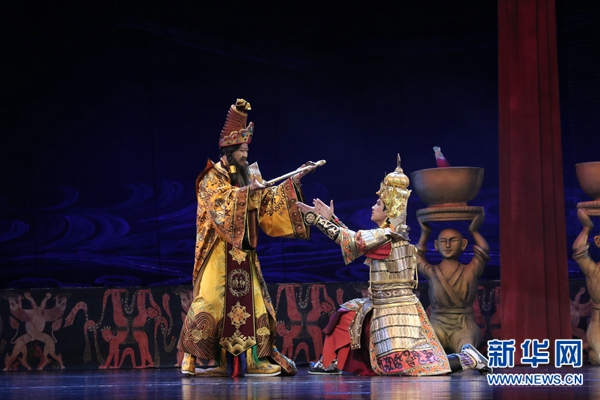Second day into Tibet's Shoton Festival - Lhamo under spotlight

With a history of more than 600 years, Tibetan Opera is one of China's oldest operatic forms and is regarded as the "living fossil of Tibetan culture." [Photo: CRIENGLISH.com/Li Jianhjua]

Tibetans start the second day by attending the Tibetan Opera, or "Lhamo" in Tibetan, which means "Sister Fairy."

Tibetans start the second day by attending the Tibetan Opera, or "Lhamo" in Tibetan, which means "Sister Fairy."
Friday marks the second day of Lhasa's Shoton Festival - the second most-celebrated festival in southwest China's Tibet.Tibetans start the second day by attending the Tibetan Opera, or "Lhamo" in Tibetan, which means "Sister Fairy."
Traditionally, the Tibetan Opera is an open circular space sheltered by a canopy, with the stage defined by a central altar.The opera tells stories that include Tibet's history, ancient legends of heroes and Gods, and satires on current events.
The opera costumes are lavish with rich brocades and a striking variety of masks and animal motifs. The music is created entirely by drums and cymbals that punctuate each movement.
"Rumor" is that the present Tibetan Opera dates back to the 14th century. At this time, a high-ranking monk and a bridge builder named Drupthok Thangthong Gyalpo decided to build iron bridges across all the major rivers in Tibet to improve local transportation and facilitate pilgrimage.
To fund the bridges, Thangthong Gyalpo put together a singing and dancing group of seven beautiful girls who performed throughout Tibet. This group of girls is believed to be the prototype of today's Tibetan Opera.
Your Comment
Name E-mailRelated News
-
;
-
-

-
Tibetan opera a hit at the Shoton Festival
During the Shoton Festival, the Tibetan Opera competition in Norbulingka Park in Lhasa has attracted many Tibetans, as well as domestic and international tourists to the show.
-
-
-

-
Cultural festival of Tibetan Opera held in Lhasa City
Performers perform in a play during a cultural festival of the Tibetan Opera in Gyabrag Village under the Doilungdeqen District of Lhasa City, southwest China's Tibet Autonomous Region, Aug. 2.
-
-
-

-
Tibetan Opera “Songtsen Gampo” debuts in Qinghai
Tibetan Opera “Songtsen Gampo“ debuted in Qinghai by the Qinghai Tibetan Opera Troup on April 29, 2016.
-
Based in Lhasa, Tibet Vista is a Tibet travel agency that specialized in Tibet permit, and Tibet tours for both private and group travelers at a local price!
•4 Days Lhasa City Group Tour from USD 460 •8 Days Everest Base Camp Group Tour from USD 850 •15 Days Mt.Kailash Group Tour from USD 1780 •2016 Tibet Train Tours from Beijing, Shanghai, Chengdu, Xining,etc










